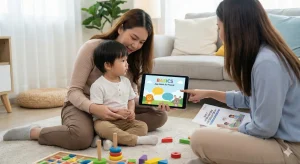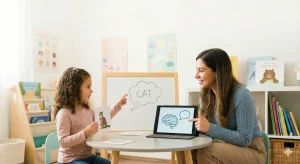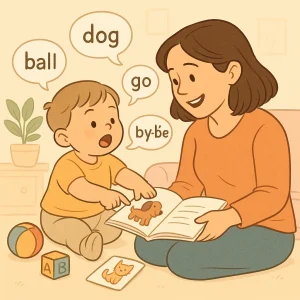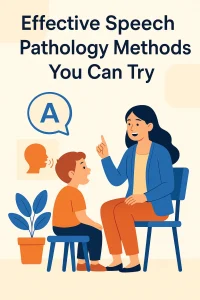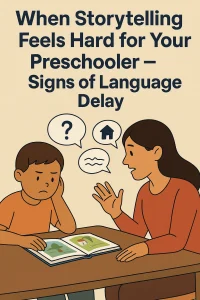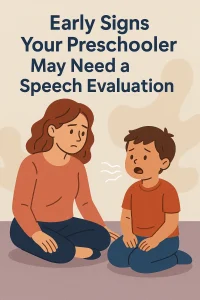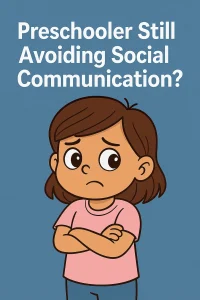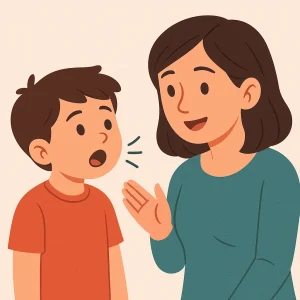From Babble To Words: Essential Books For Toddler Talk
Last Updated: August 13, 2025
Reading with your toddler is not just a cozy, shared activity; it is a powerful tool for speech development. During these precious moments, your little one is not only entertained but is also learning to recognize sounds, imitate words, and develop critical communication skills. Books are an engaging and effective way to help toddlers transition from babbling to forming words and sentences.
Books with colorful pictures, simple texts, and repetitive phrases are particularly beneficial. They capture your toddler’s attention and encourage them to mimic sounds and words. This practice is essential for developing their speech and language skills. By incorporating reading into your daily routine, you are providing your child with a fun and interactive way to enhance their vocabulary and communication abilities.
Free Speech Help for Kids
Concerned about speech delays? Book a free consultation with our expert speech therapist and get guidance tailored to your child’s needs.
Why Reading is Crucial for Toddler Speech Development
Reading with your toddler is more than just a delightful activity; it’s a fundamental part of their speech and language development. Here are some key reasons why reading is so crucial for toddlers:
Helps Build Communication Skills
When you read with your toddler, you are introducing them to the sounds and rhythms of language. This exposure helps them learn how to form words and sentences, building the foundation for effective communication. Books often include repetitive phrases and simple words that make it easier for toddlers to grasp and imitate.
For example, books like “First 100 Words” use everyday vocabulary and clear images to help toddlers connect words with objects. By regularly reading such books, your child will start to recognize and say new words, enhancing their vocabulary and communication skills.
Also read: Boost Speech in Toddlers: Fun Home Activities for 1-2 Year Olds
Encourages Listening and Understanding
Reading aloud to your toddler also plays a vital role in developing their listening and comprehension skills. Toddlers learn to pay attention to the words you say and begin to understand the story and context. This practice improves their ability to follow directions and comprehend more complex sentences as they grow.
Books with engaging stories and interactive elements, like “Brown Bear, Brown Bear, What Do You See?” encourage toddlers to listen carefully and anticipate what comes next. This not only keeps them engaged but also helps them practice listening and understanding, which are essential skills for effective communication.
Promotes Bonding Between Parent and Child
Beyond the educational benefits, reading with your toddler is a wonderful way to bond. The close physical proximity and shared experience create a nurturing environment that strengthens your relationship. This emotional connection makes reading time enjoyable and memorable for both of you.
Books like “Goodnight Moon” provide a soothing and familiar routine that can be a comforting end to your toddler’s day. The repetitive phrases and calming illustrations help create a peaceful atmosphere, making storytime a cherished part of your daily routine.
Key Speech and Language Skills Enhanced by Reading
Reading with your toddler is not just about enjoying stories together; it’s also a powerful tool for enhancing various speech and language skills. Here are some key areas where reading can make a significant impact:
Identifying Pictures and Objects
Books with bright, clear images help toddlers learn to identify and name different objects and pictures. This process is foundational for building their vocabulary. For instance, when reading a book like “First 100 Words,” you can point to pictures and say the names of the items. This helps your child associate words with images, improving their ability to recognize and label objects.
Imitating Sounds, Gestures, and Words
Books that incorporate sounds and gestures are excellent for encouraging toddlers to imitate. Imitation is a crucial step in learning to speak. Interactive books like “Poke-a-Dot” engage toddlers with sounds and actions they can mimic. When you model these sounds and gestures, your child will try to copy you, which enhances their speech and motor skills.
Practicing Verbalization and Sentence Structure
As toddlers progress, they begin to practice forming words and simple sentences. Books with repetitive phrases, such as “Brown Bear, Brown Bear, What Do You See?” provide ample opportunities for your child to repeat words and phrases, helping them learn sentence structure. You can pause during reading to let your child fill in the blanks, promoting verbalization and sentence construction.
Enhancing Vocabulary and Understanding Language
Reading a variety of books exposes toddlers to new vocabulary and different language structures. Books like “If You Give a Mouse a Cookie” use a story format that introduces new words in context, making it easier for toddlers to understand and remember them. Regular reading helps toddlers expand their vocabulary and grasp the nuances of language.
Developing Socioemotional Skills and Problem-Solving
Books also play a crucial role in developing socioemotional skills and problem-solving abilities. Stories often involve characters experiencing different emotions and facing various challenges. For example, “The Bad Seed” and “Jabari Jumps” explore themes of emotions and overcoming fears. Discussing these stories with your child helps them understand and express their own feelings and think through solutions to problems.
Essential Books for Toddler Talk
First 100 Words
“First 100 Words” is a wonderfully simple yet powerful book filled with photos of everyday items. It’s designed specifically to help toddlers start identifying and naming the objects they see around them daily. Each page is packed with vibrant images of familiar items that are easy for toddlers to recognize and learn.
Skills Targeted:
- Vocabulary Building: The book introduces a wide range of words that toddlers encounter in their everyday environment. This exposure helps in expanding their vocabulary.
- Labeling Items: By seeing pictures and hearing the corresponding words, toddlers learn to label the objects, which is a crucial step in language development.
Reading Tips:
- Point to Your Mouth: When reading “First 100 Words” with your toddler, point to your mouth as you pronounce each word. This helps them see how sounds are formed and encourages them to imitate you.
- Repeat Words: Repetition is key to learning. Say each word multiple times, emphasizing different parts of the word to make it more memorable. For example, you can say “Milk, milk” and emphasize the beginning sound, “Mmmm-milk.”
- Use in Sentences: To help your child understand how words fit into everyday speech, use the target words in simple sentences. For example, if there is a picture of a dog, you can say, “This is a dog. The dog is cute.” This method helps toddlers grasp the context in which words are used.
Brown Bear, Brown Bear, What Do You See?
“Brown Bear, Brown Bear, What Do You See?” is a classic, repetitive, and rhythmic book by Eric Carle. It’s loved by toddlers and parents alike for its engaging, predictable pattern, which makes it easy for young children to follow along and join in.
Skills Targeted:
- Imitating Phrases: The repetitive nature of the book encourages toddlers to imitate phrases, helping them practice verbalization and sentence formation.
- Fill-in-the-Blank Activities: The predictable pattern of the text allows for interactive fill-in-the-blank activities, prompting toddlers to recall and say the next phrase.
Reading Tips:
- Pause for Your Child to Finish Phrases: As you read, pause at strategic points to let your child fill in the blanks. For example, say, “Brown Bear, Brown Bear, what do you…” and let your child complete the phrase with “see.” This practice helps them engage with the story and builds their confidence in speaking.
- Practice Labeling Animals: Each page introduces a new animal, making it a perfect opportunity to practice labeling. Ask your child to name the animal and make the corresponding sound. For instance, when you see the “red bird,” encourage your child to say “bird” and imitate a bird sound.
Poke-a-Dot Books
Poke-a-Dot books are a series of interactive books featuring poppable dots that make a satisfying “pop” sound when pressed. These books are designed to engage young children through sensory play, making reading a multi-sensory experience.
Skills Targeted:
- Gesture Imitation: By popping the dots, toddlers can practice imitating gestures, which is a fundamental step in developing motor skills and verbal communication.
- Verbalization: Encouraging your child to label items on the page and say phrases associated with the images helps improve their verbalization skills.
Reading Tips:
- Model Popping Dots: Show your child how to pop the dots and let them mimic your actions. This interactive element keeps them engaged and helps them develop fine motor skills.
- Encourage Labeling and Saying Phrases: Use the images and the popping activity to prompt your child to name objects and say simple phrases. For instance, you can point to a picture of a dog and say, “Dog, pop!” or create a phrase like, “Pop the red dot.”
From Head to Toe
“From Head to Toe” is a delightful book by Eric Carle that focuses on action words and encourages children to imitate gestures. Each page features different animals performing actions, which toddlers can mimic, making it a fun and interactive reading experience.
Skills Targeted:
- Gesture Imitation: The book’s emphasis on actions helps toddlers practice imitating gestures, a crucial step in developing both motor skills and language.
- Learning Action Words: By associating words with actions, toddlers can expand their vocabulary and learn to understand and use action words in their daily lives.
Reading Tips:
- Encourage Your Child to Imitate Actions: As you read each page, demonstrate the actions yourself and encourage your child to follow along. For example, if the book says, “I am a gorilla and I thump my chest,” thump your chest and have your child do the same. This helps reinforce the connection between words and actions.
- Practice Using Action Words in Phrases: Use the action words from the book in simple phrases throughout the day. For instance, if the book says “kick,” you can say, “Can you kick the ball?” This practice helps your child understand how to use these words in context, enhancing their language development.
If You Give a Mouse a Cookie
“If You Give a Mouse a Cookie” is a charming, repetitive book that provides plenty of opportunities for toddlers to practice imitation and answer questions. The story’s predictable pattern makes it easy for children to follow along and join in.
Skills Targeted:
- Imitating Phrases: The repetitive nature of the book helps toddlers practice imitating phrases, enhancing their verbal skills.
- Answering Questions: Throughout the story, you can ask your child questions about what is happening, which helps develop their comprehension and response skills.
- Sentence Structure: By hearing and repeating complete sentences, toddlers learn proper sentence structure, improving their language development.
Reading Tips:
- Ask Questions: Engage your child by asking questions about the story. For example, “Why does the mouse need a napkin?” or “What happens after the mouse drinks the milk?” This interaction helps improve their understanding and ability to form responses.
- Encourage Complete Sentences: When your child answers a question, gently encourage them to use complete sentences. If they say, “Mouse drink,” you can model the full sentence: “The mouse drinks the milk.”
- Practice Repeating Phrases: Pause during the reading to let your child repeat key phrases. For instance, you can say, “If you give a mouse a…” and let your child finish with “cookie.” This repetition reinforces their language skills and helps them feel confident in speaking.
Dear Zoo
“Dear Zoo” is a classic lift-the-flap book that is both interactive and engaging for toddlers. The story follows a child who writes to the zoo to send them a pet, and each flap reveals a different animal sent by the zoo.
Skills Targeted:
- Animal Sounds: The book introduces various animals, making it perfect for practicing animal noises, which is a fun way to enhance phonetic skills.
- Gestures: The interactive nature of lifting flaps and mimicking animal actions helps toddlers develop their motor skills and understand gestures associated with different animals.
Reading Tips:
- Model Animal Noises: As you reveal each animal, model the corresponding animal noise. For example, when you lift the flap to show the lion, you can roar. Encourage your child to repeat the sound, which helps with their articulation and phonetic awareness.
- Use Gestures: Incorporate gestures like knocking on the boxes before lifting the flaps. You can say, “Let’s see who’s inside!” while pretending to knock. This makes the reading session more interactive and engaging, helping your child connect actions with words.
Goodnight Moon
“Goodnight Moon” is a beloved classic bedtime book featuring simple, repetitive phrases. It takes readers through a quiet, soothing journey of saying goodnight to various objects and characters in a room.
Skills Targeted:
- Gesture Imitation: The repetitive nature of the book allows toddlers to mimic gestures, enhancing their motor skills.
- Sound Imitation: Encourages toddlers to imitate sounds, particularly the calming “shhhh” sound, which is great for phonetic development.
Reading Tips:
- Encourage Saying “Night Night”: As you read, encourage your toddler to say “Night Night” to each object or character in the book. This repetition helps them practice speaking in a gentle, comforting manner.
- Practice the “Shhhh” Sound: Whenever the book mentions quieting down, model the “shhhh” sound and have your child imitate it. This not only helps with sound imitation but also creates a calming bedtime routine.
Book List and Skills Targeted
| Book Title | Skills Targeted |
|---|---|
| First 100 Words | – Vocabulary building: Introduces a wide range of everyday words. – Labeling items: Helps toddlers learn to associate words with pictures. |
| Brown Bear, Brown Bear, What Do You See? | – Imitating phrases: Encourages toddlers to repeat simple, repetitive phrases. – Fill-in-the-blank activities: Promotes active participation by letting children finish sentences. |
| Poke-a-Dot Books | – Gesture imitation: Engages toddlers in physical activity by popping dots. – Verbalization: Encourages naming objects and saying simple phrases. |
| From Head to Toe | – Gesture imitation: Promotes copying actions shown in the book. – Learning action words: Teaches verbs and actions through interactive play. |
| If You Give a Mouse a Cookie | – Imitating phrases: Helps toddlers practice repeating sentences. – Answering questions: Enhances comprehension by prompting toddlers to answer questions. – Sentence structure: Reinforces understanding of sentence construction. |
| Dear Zoo | – Animal sounds: Encourages making and recognizing different animal noises. – Gestures: Involves physical actions like lifting flaps and mimicking animal movements. |
| Goodnight Moon | – Gesture imitation: Reinforces calming actions like waving goodnight. – Sound imitation: Encourages making soothing sounds like “shhhh.” |
Also Read: Tips to Develop Good Learning Habits
Tips for Reading with Your Toddler
Reading with your toddler is a wonderful way to enhance their speech development and create lasting memories. Here are some tips to make your reading sessions both educational and enjoyable:
Interactive Reading Tips
| Tip | Description |
|---|---|
| Make reading interactive and fun | Use interactive books with flaps, textures, or sounds to keep your toddler engaged and make learning fun. |
| Use gestures and facial expressions | Dramatize the story by using exaggerated gestures and facial expressions to captivate your child’s attention. |
| Repeat words and phrases often | Reinforce learning by repeating key words and phrases, helping your toddler to remember and practice them. |
| Follow your child’s interests and let them lead | Let your child choose the books and follow their curiosity during reading sessions to keep them engaged and motivated. |
| Be patient and encouraging | Praise your child’s efforts and provide positive reinforcement to build their confidence and encourage continued learning. |
Know more about our article on How to Improve Memory in Studies? | How to Memorize Well?
Conclusion
Using books to help toddlers talk is a fun and effective way to support their speech development. We’ve explored various books that can help build vocabulary, encourage imitation of sounds and gestures, and improve sentence structure. Reading with your toddler not only helps them learn to communicate but also strengthens your bond with them.
We encourage you to try the recommended books and techniques to support your child’s language development. Each book offers unique ways to interact and learn, making story time both fun and educational. Keep reading, keep interacting, and enjoy watching your child’s language skills grow. For more tips and resources, visit Wellness Hub. Happy reading and happy talking!
Frequently Asked Questions:
1. What are the best books to help toddlers talk?
The best books to help toddlers talk include “First 100 Words,” “Brown Bear, Brown Bear, What Do You See?,” “Poke-a-Dot Books,” “From Head to Toe,” “If You Give a Mouse a Cookie,” “Dear Zoo,” and “Goodnight Moon.” These books are designed to engage toddlers and promote speech and language development through repetition, interactive elements, and simple phrases.
2. How can books improve my toddler’s speech?
Books improve your toddler’s speech by exposing them to new words, sounds, and sentence structures. Reading together encourages toddlers to imitate sounds, gestures, and words, helping to build their vocabulary and communication skills. Interactive books also make learning fun and engaging.
3. Which books are essential for toddler language development?
Essential books for toddler language development include “First 100 Words” for vocabulary building, “Brown Bear, Brown Bear, What Do You See?” for imitating phrases, “Poke-a-Dot Books” for gesture imitation, “From Head to Toe” for learning action words, “If You Give a Mouse a Cookie” for practicing sentence structure, “Dear Zoo” for animal sounds and gestures, and “Goodnight Moon” for soothing bedtime routines.
4. What books can help with toddler speech delays?
Books that can help with toddler speech delays include “First 100 Words,” “Brown Bear, Brown Bear, What Do You See?,” and “Poke-a-Dot Books.” These books focus on repetition, simple phrases, and interactive elements, which can be beneficial for toddlers experiencing speech delays.
5. Are there books that boost toddler talking skills?
Yes, books like “From Head to Toe” and “If You Give a Mouse a Cookie” are great for boosting toddler talking skills. These books encourage toddlers to imitate actions and phrases, answer questions, and practice using complete sentences.
6. How often should I read to my toddler to improve their speech?
It is beneficial to read to your toddler daily to improve their speech. Consistent reading helps reinforce new words and sounds, making it easier for toddlers to learn and use them in everyday conversations.
7. What are some interactive reading tips for toddlers?
Some interactive reading tips for toddlers include using gestures and facial expressions, repeating words and phrases often, following your child’s interests, letting them lead the reading session, and being patient and encouraging. These techniques make reading more engaging and effective for language development.
8. Can bedtime stories help with my toddler’s language skills?
Yes, bedtime stories like “Goodnight Moon” can help with your toddler’s language skills. The repetitive phrases and calming nature of bedtime stories encourage toddlers to imitate sounds and gestures, building their vocabulary and communication abilities in a soothing environment.
9. How can I make reading sessions more engaging for my toddler?
To make reading sessions more engaging for your toddler, use a variety of techniques such as changing your voice for different characters, asking questions about the story, and incorporating physical actions related to the book’s content. Interactive books with flaps, textures, or sounds also keep toddlers interested and involved.
10. What should I do if my toddler loses interest in a book?
If your toddler loses interest in a book, follow their lead and switch to another book or activity they are more interested in. It’s important to keep reading sessions positive and enjoyable. You can also try making the story more interactive by involving your child in the reading process, such as letting them turn the pages or guess what happens next.
About the Author:
Anuradha Karanam
Speech-language pathologist (7+ years of experience)
Anuradha Karanam is a skilled speech-language pathologist with over 6 years of experience. Fluent in Tamil, Telugu, Hindi, and English, she specializes in parent counseling, speech sound disorders, fluency assessment, and speech-language evaluations. Anuradha excels at working with children with developmental disorders, offering creative and effective therapy programs. Currently, at Wellness Hub, she holds a BASLP degree and is registered with the RCI (CRR No A85500). Her patience, ambition, and dedication make her a trusted expert in her field.
Book your Free Consultation Today
Parent/Caregiver Info:
Client’s Details:
* Error Message
